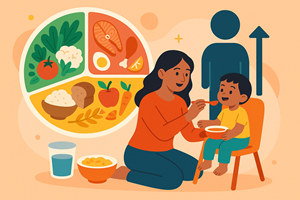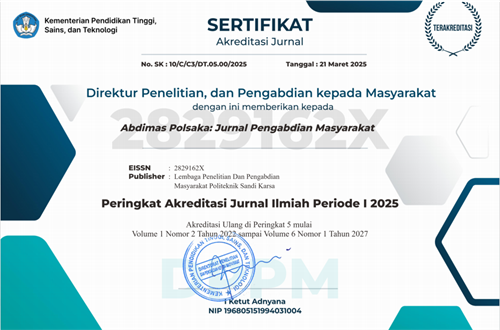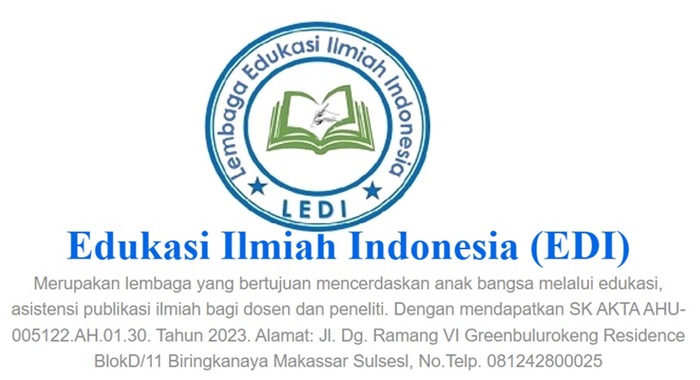Balanced nutrition education as an effort to prevent stunting in toddlers
DOI:
https://doi.org/10.35816/abdimaspolsaka.v4i2.105Keywords:
Balanced Nutrition, Stunting, ToddlersAbstract
Nutritional problems in toddlers, including stunting, wasting, and overweight, remain a major global health concern. Stunting is closely linked to specific deficiencies in vitamins and minerals, influenced by factors such as maternal education, family income, maternal knowledge of nutrition, breastfeeding practices, complementary feeding age, micronutrient adequacy, infection history, and genetics. This community service program aimed to increase maternal knowledge of balanced nutrition to prevent stunting in toddlers. The activity was conducted on January 20, 2025, at the Posyandu in the Pattingalloang Community Health Center working area, involving 20 participants, supported by lecturers, students, midwives, and local health cadres. Educational interventions were delivered through lectures, discussions, and Q&A sessions. Pre-test results showed that 65% of participants had good knowledge and 35% had poor knowledge regarding balanced nutrition and stunting prevention. Post-test results indicated an improvement, with 80% demonstrating good knowledge and only 20% remaining in the poor category. The findings highlight that targeted nutrition education can significantly improve maternal understanding and awareness, which may contribute to reducing stunting prevalence. Follow-up programs and home-based health services were also recommended to sustain knowledge and improve child health outcomes.
Downloads
References
D. Arda, N. N. L. N. Lalla, and S. Suprapto, “Analysis of the Effect of Malnutrition Status on Toddlers,” J. Ilm. Kesehat. Sandi Husada, vol. 12, no. 1, pp. 111–116, Jun. 2023, doi: https://doi.org/10.35816/jiskh.v12i1.910.
S. A. Latif, A. Adam, and S. A. Kamaruddin, “Economic Income as a Cause of Stunting: an Analysis Based on the Perspective of Karl Marx: Literature Review,” J. Ilm. Kesehat. Sandi Husada, vol. 14, no. 1, pp. 1–7, Jun. 2025, doi: https://doi.org/10.35816/jiskh.v14i1.1231.
R. Millati, A. Setyawati, I. Aris Tyarini, and I. Daiyah, “Capacity building of posyandu cadres through education and training in stunting prevention,” Abdimas Polsaka, vol. 4, no. 1, pp. 08–14, Mar. 2025, doi: https://doi.org/10.35816/abdimaspolsaka.v4i1.84.
H. Hatijar, A. Setiawati, L. Situmeang, I. Aris Tyarini, S. Zakiyyah Putri, and L. Yunita, “Balanced nutrition education as an effort to prevent stunting in toddlers,” J. Pengabdi. Masy. Edukasi Indones., vol. 2, no. 2, pp. 39–46, May 2025, doi: https://doi.org/10.61099/jpmei.v2i2.74.
W. Ode Novi Angreni, D. Arda, A. Setyawati, A. Sasmita, I. Aris Tyarini, and N. Nordianiwati, “Exclusive breastfeeding in preventing stunting in toddlers,” J. Edukasi Ilm. Kesehat., vol. 2, no. 1, pp. 07–13, Mar. 2024, doi: https://doi.org/10.61099/junedik.v2i1.29.
S. Suprapto, “Pengaruh Edukasi Media Kartun Terhadap Peningkatan Pengetahuan Ibu dan Status Gizi Anak,” J. Heal., vol. 9, no. 2, pp. 81–87, Jul. 2022, doi: https://doi.org/10.30590/joh.v9n2.500.
K. Rahmadhita, “Permasalahan Stunting dan Pencegahannya,” J. Ilm. Kesehat. Sandi Husada, vol. 11, no. 1, pp. 225–229, Jun. 2020, doi: https://doi.org/10.35816/jiskh.v11i1.253.
I. Irma, S. N. Rahman, H. Ryska, and V. Hadju, “Determinants of chronic energy deficiency (CED) in pregnant women in stunting,” J. Ilm. Kesehat. Sandi Husada, vol. 14, no. 1, pp. 201–210, Jun. 2025, doi: https://doi.org/10.35816/jiskh.v14i1.1282.
H. Ashar et al., “A qualitative study in Magelang Central Java Indonesia: Mothers’ knowledge, parenting styles and national priority programs managing of stunting in toddlers,” Soc. Sci. Humanit. Open, vol. 12, p. 101874, 2025, doi: https://doi.org/10.1016/j.ssaho.2025.101874.
E. Gupta et al., “Food Allergy, Nutrition, Psychology, and Health,” J. Allergy Clin. Immunol. Pract., vol. 13, no. 4, pp. 773-782.e2, 2025, doi: https://doi.org/10.1016/j.jaip.2024.09.036.
L. A. Garina et al., “Maternal, Child, and Household Risk Factors for Children with Stunting,” Open Public Health J., vol. 17, no. 1, Sep. 2024, doi: https://dx.doi.org/10.2174/0118749445321448240823112908.
L. Li, Y. Li, J. Shi, X. Li, H. Liu, and L. Zhu, “Unveiling the role of early child development in preventing poverty transmission in deep poverty-stricken areas of RuralChina,” J. Rural Stud., vol. 114, p. 103577, Feb. 2025, doi: https://doi.org/10.1016/j.jrurstud.2025.103577.
F. Abate et al., “UNITY: A low-field magnetic resonance neuroimaging initiative to characterize neurodevelopment in low and middle-income settings,” Dev. Cogn. Neurosci., vol. 69, p. 101397, Oct. 2024, doi: https://dx.doi.org/10.1016/j.dcn.2024.101397.
R. Gutiérrez-Romero, “The intergenerational impact of electoral violence on height and human capital,” J. Econ. Behav. Organ., vol. 220, pp. 608–630, Apr. 2024, doi: https://dx.doi.org/10.1016/j.jebo.2024.02.025.
I. D. Kurnia, P. D. Rachmawati, Y. S. Arief, I. Krisnana, P. Rithpho, and H. Arifin, “Factors associated with infant and young child feeding practices in children aged 6–23 months in Indonesia: A nationwide study,” J. Pediatr. Nurs., vol. 78, pp. 82–88, Sep. 2024, doi: https://dx.doi.org/10.1016/j.pedn.2024.06.006.
K. A. Erika et al., “Stunting Super App as an Effort Toward Stunting Management in Indonesia: Delphi and Pilot Study,” JMIR Hum. Factors, vol. 11, pp. e54862–e54862, Dec. 2024, doi: https://dx.doi.org/10.2196/54862.
A. Kustanto, O. Rachmat, and S. Setyadi, “The Prevalence of Stunting in Indonesia: An Examination of the Health, Socioeconomic Status, and Environmental Determinants,” J. Iran. Med. Counc., Nov. 2024, doi: https://dx.doi.org/10.18502/jimc.v8i1.17062.
S. Winarni, Z. Shaluhiyah, S. Sulistyawati, N. Lisnawati, A. Hulaila, and N. O. Chumair, “Knowledge, Attitudes, Eating Practices, and Iron (Fe) Consumption among Adolescent Girls (Aged 10-18 Years) in Central Java, Indonesia,” Open Public Health J., vol. 17, no. 1, Nov. 2024, doi: https://doi.org/10.2174/0118749445352293241105110603.
V. Pahuja and S. Sanghvi, “Childhood obesity in South Asian population,” Obes. Pillars, vol. 12, p. 100148, Dec. 2024, doi: https://doi.org/10.1016/j.obpill.2024.100148.
R. Sentika et al., “Expert Consensus on Interprofessional Collaboration (IPC) Guidelines on Stunting Management in Indonesian Primary Healthcare (Puskesmas),” Open Public Health J., vol. 17, no. 1, Dec. 2024, doi: https://doi.org/10.2174/0118749445352608241119164446.

Additional Files
Published
How to Cite
Issue
Section
License
Copyright (c) 2025 Dahniar Dahniar, Arisna Kadir

This work is licensed under a Creative Commons Attribution 4.0 International License.
Most read articles by the same author(s)
- Arisna Kadir, Dahniar Dahniar, Indah Yun Diniaty Rosidi, Breast Self Examination (BSE) Training for Early Detection of Breast Cancer in Women of Childbearing Age , Abdimas Polsaka: Vol. 2 No. 2 (2023): Abdimas Polsaka: Jurnal Pengabdian Masyarakat




















